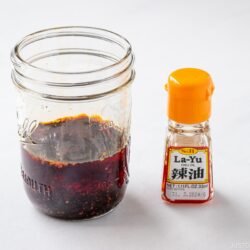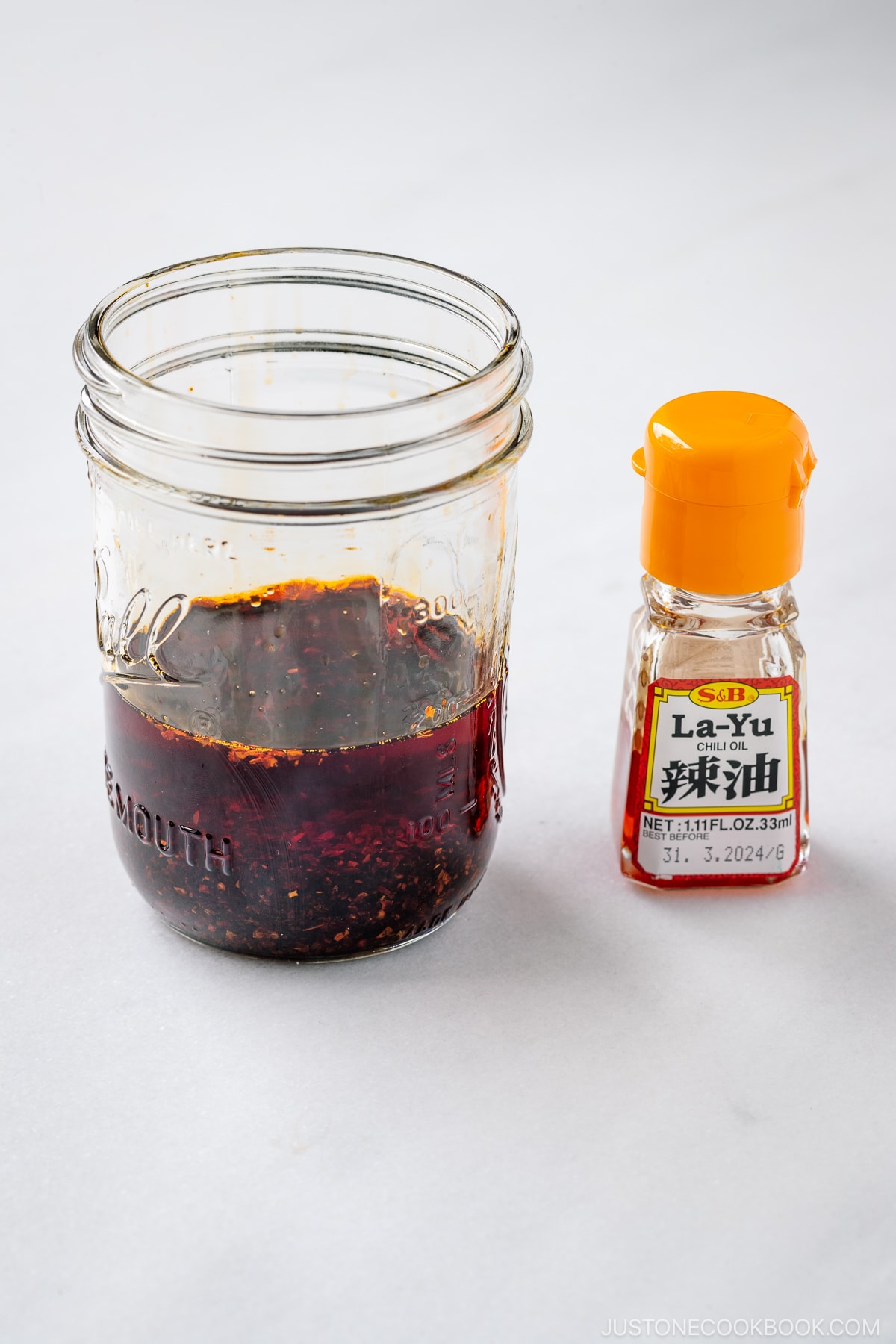
Do you love chili oil with a passion? Have you tried making your own? Luckily, it’s really easy to make your own spicy condiment at home. Today we’ll make Japanese Chili Oil called La-yu (ラー油). This homemade la-yu is fragrant, fresh-tasting, and amazingly delicious. Thanks to the addition of Sichuan peppercorn, it imparts a unique floral aroma and a tingling sensation. The result is quite different from the commercial versions and you will absolutely love drizzling it on everything!
The best thing about making la-yu at home? You can adjust the amount of chili to suit your preference—from mild to extra spicy!
What is La-yu?
La-yu (ラー油, 辣油), sometimes spelled as rayu or ra yu, is a Japanese chili-flavored oil made by adding chili peppers to sesame oil and heating the oil to give it spiciness. La-yu is mostly used in Japanese-style Chinese foods (Chuka ryori).
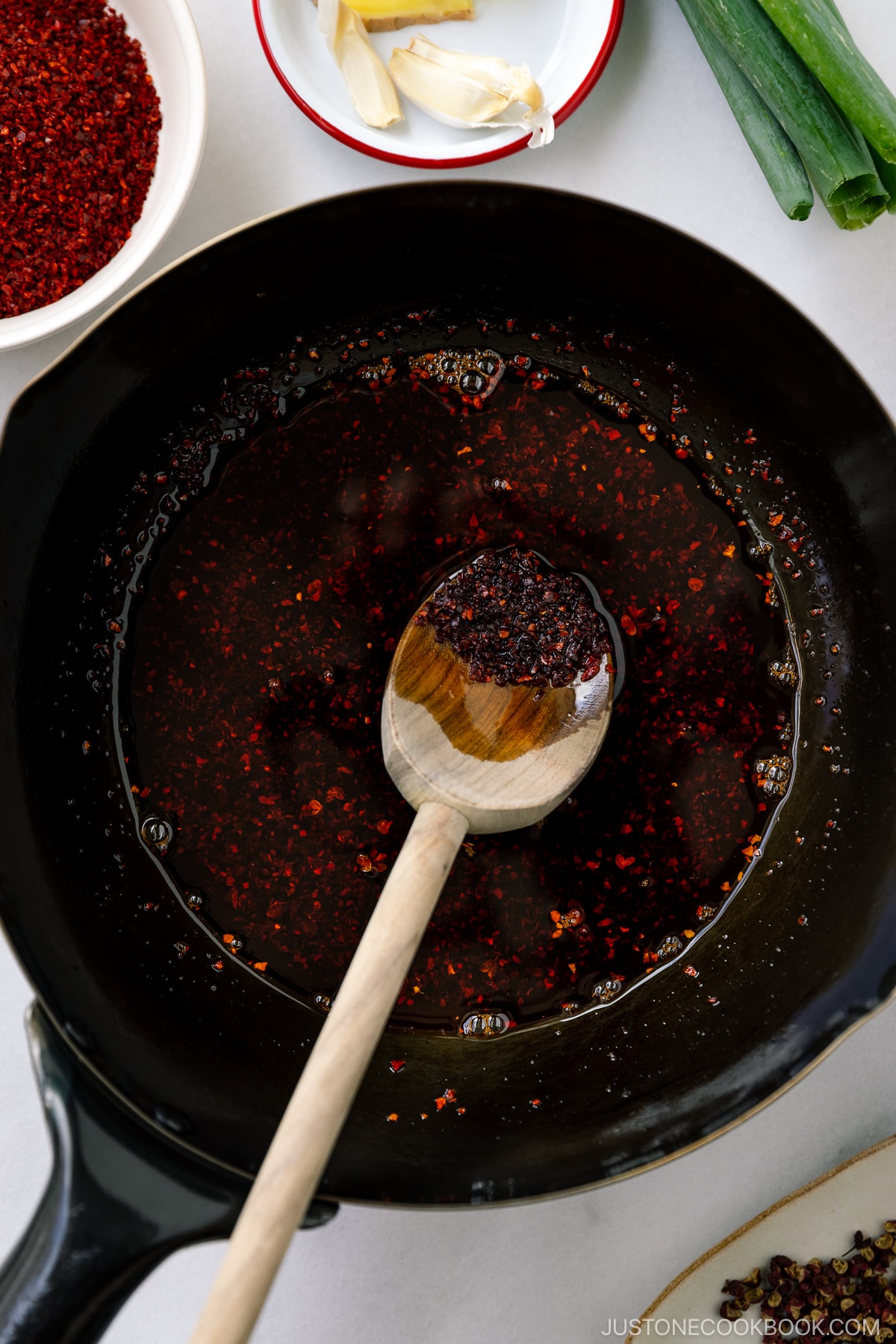
How to Make Layu
Ingredients You’ll Need
- Neutral-flavored oil – I use untoasted (clear) sesame oil.
- Roasted sesame oil
- Tokyo Negi Green – You can use the green part of green onions/scallions.
- Ginger
- Garlic
- Japanese chili peppers (ichimi togarashi) – I use Korean chili flakes (gochugaru). I will talk more about this below.
- Sichuan peppercorns – More about it below.
Overview: Cooking Steps
- Gently heat the oil and aromatics on low heat for 15 minutes.
- Add the chili flakes and Sichuan peppercorns to the oil and let it steep while cooling down completely.
- Transfer to a clean glass jar and store it properly.
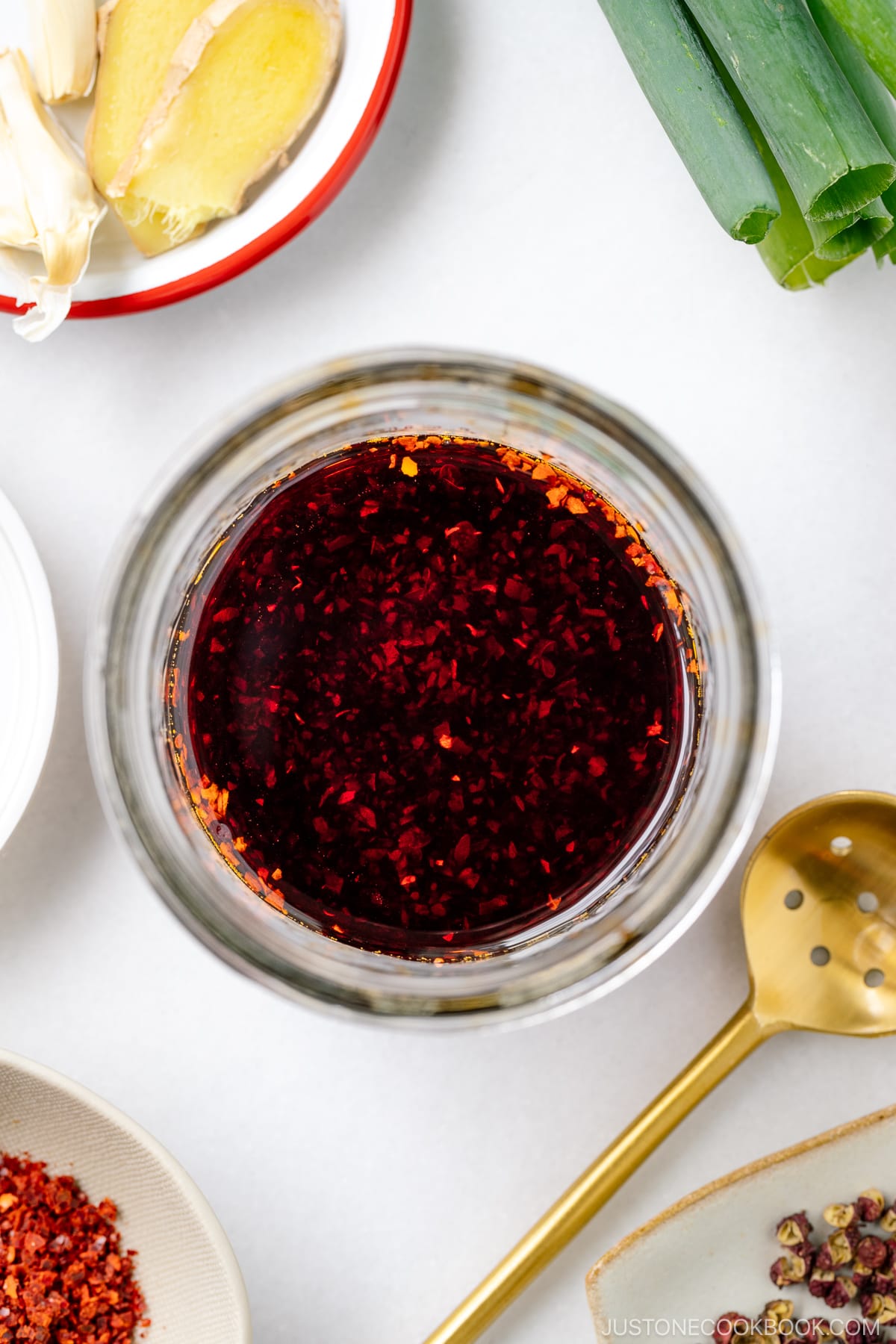
Best Oil for Making La-Yu
Traditionally, sesame oil is used to make la-yu. However, I like to use both neutral-flavored oil and roasted sesame oil for making homemade la-yu. Neutral flavored oil includes peanut oil, canola oil, corn oil, or vegetable. I use this untoasted sesame oil for my cooking.
Japanese vs. Korean Chili Peppers
There are thousands of varieties of chili peppers that are cultivated and used in cooking all over the world. For making la-yu, I recommend two types: Japanese and Korean chili peppers.
La-yu is typically made with Japanese chili peppers or ichimi togarashi (一味唐辛子). Most Japanese people use just a few dollops of la-yu in dishes because it is quite spicy to our taste and we are not used to eating spicy food. If that resonates with you, may I suggest using gochugaru instead?
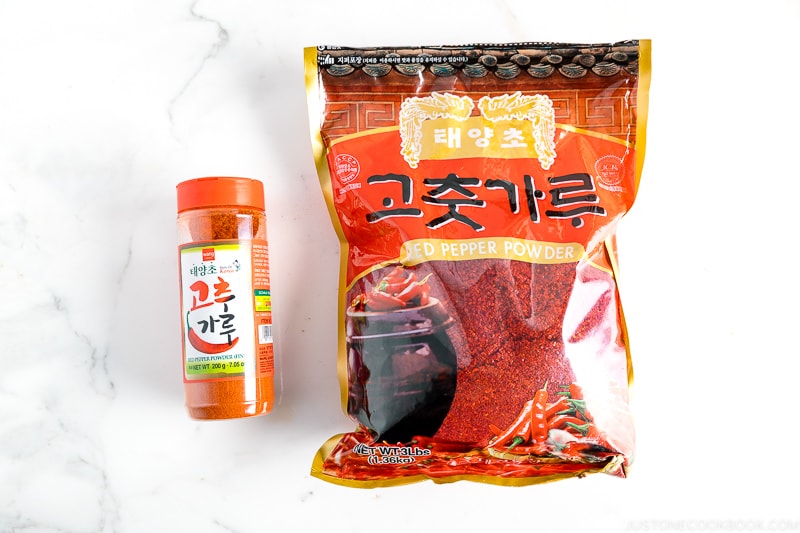
Japanese chili peppers (ichimi togarashi) and Korean chili peppers (gochugaru) are different varieties. Korean chili peppers contain less capsaicin so they are not as spicy as the ichimi togarashi yet they have umami and sweetness.
Where to Find Japanese and Korean Chili Peppers
- Ichimi togarashi on Amazon
- Gochugaru on Amazon
- Online Asian Grocery Stores
Sichuan Peppercorns
Sichuan peppercorns impart a unique floral aroma and a tingling sensation. You can add more Sichuan peppercorns if you like them. I got the peppercorns from Mala Market, but you can also purchase them on Amazon.
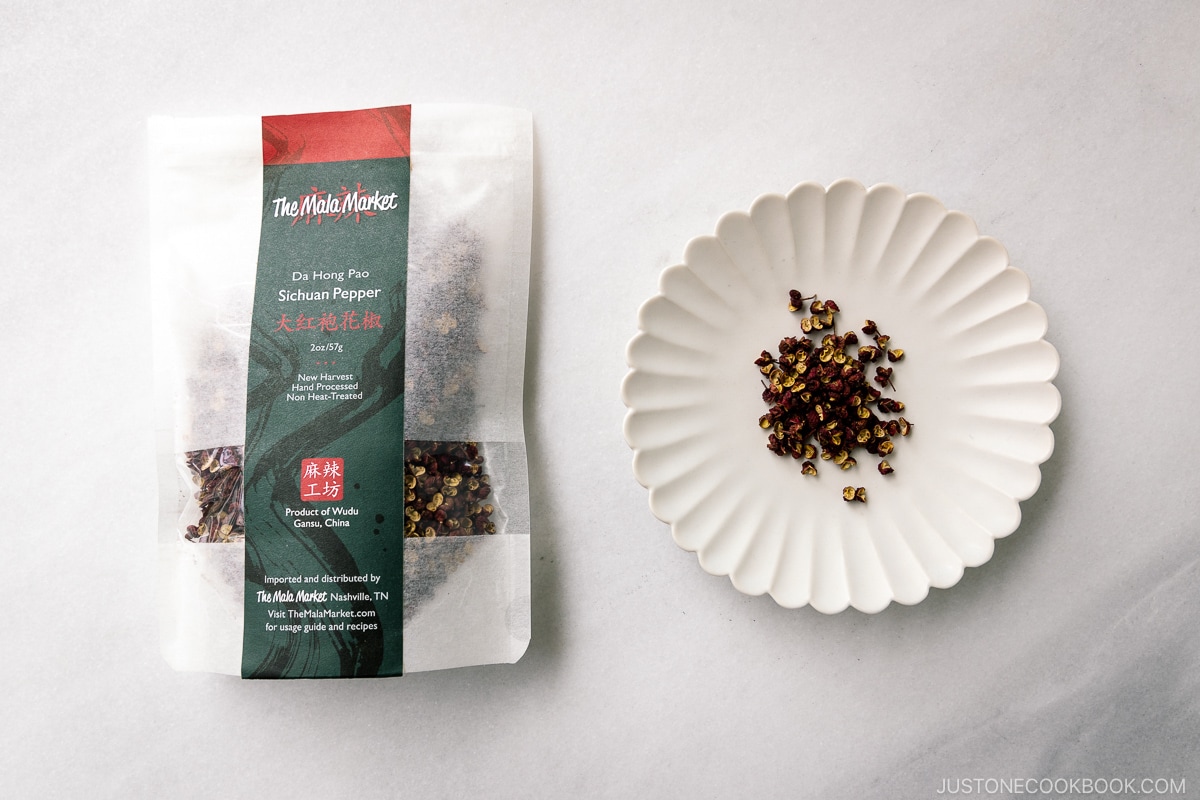
Cooking Tips
- Make sure all the aromatics are dry. If you wash the Tokyo negi (green onions), for example, make sure they are completely dry to avoid oil splatters.
- Cook the oil with aromatics for 15 minutes. When you see the oil sizzling, set the timer for 15 minutes.
- Do not burn the aromatics. Keep the heat low when you infuse the oil with the aromatics and do not let your oil smoke. Burnt aromatics will result in a bitter taste.
- Turn off the heat and remove the pot from the stove before adding the chili flakes. Most recipes would pour the hot oil over the chili flakes in a bowl. But my method is to turn off the heat, quickly remove the cooking pot/pan from the stove, and then add the chili flakes. This is to prevent the oil from smoking, which can then burn the chili flakes, and you won’t need to worry about spilling the hot oil.
How to Store La-yu
Store the la-yu in a clean, sterilized glass jar for 1-2 months in the refrigerator. Chili oil can go bad and should be discarded if it has a rancid smell or a very unpleasant flavor.
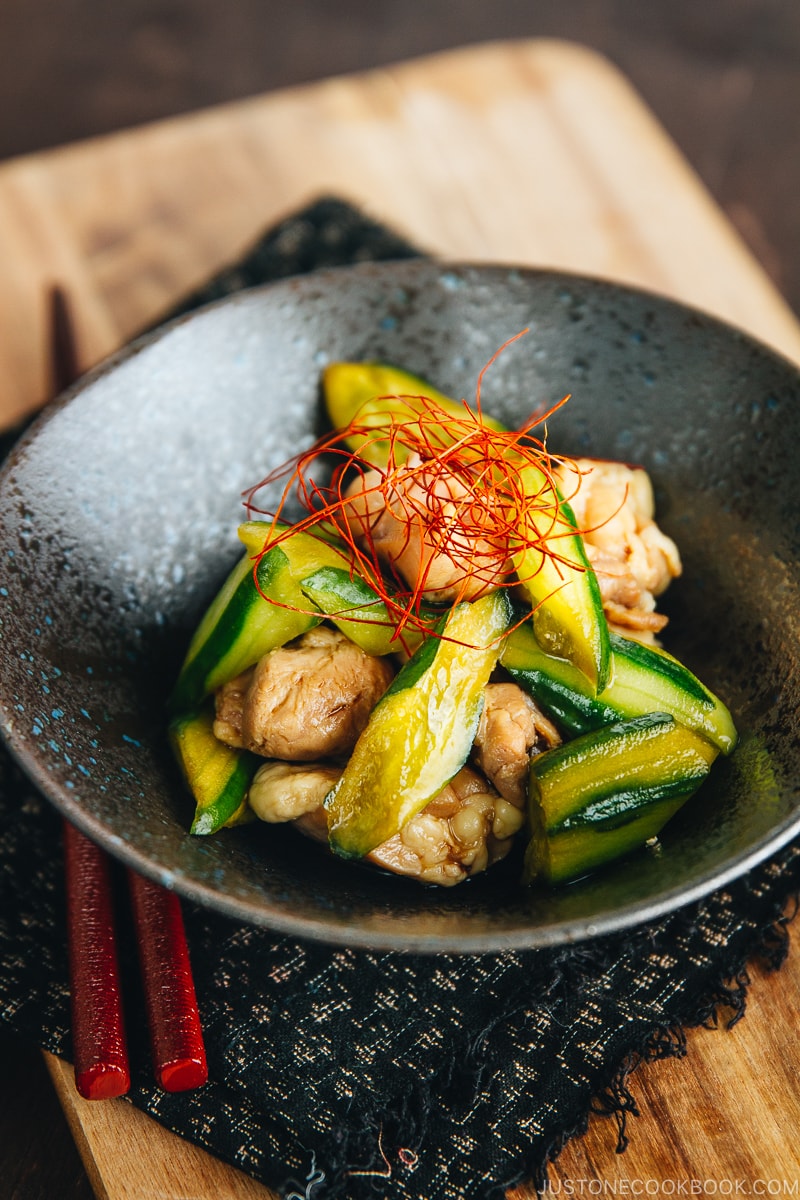
How to Use La-yu
You can serve the chili oil as a condiment or stir it into a variety of dishes, like stir-fries, noodles, and dressings. In Japan, we add a bit of la-yu to spice up any dish but mostly used in Japanese-style Chinese foods (Chuka ryori).
You can drizzle it directly onto dishes like Miso Ramen, Black Sesame Dan Dan Noodles, and Mapo Tofu. Try it in a dipping sauce for Gyoza (Japanese Potstickers), Vegetable Gyoza, and Pork Shumai.
La-yu is also delicious in a dressing for blanched vegetables like Chrysanthemum Greens Salad or in a marinade for dishes like Spicy Japanese Pickled Cucumbers and Cucumber and Chicken Marinated in Chili Oil.
More Japanese Condiment Recipes to Make at Home
- Homemade Furikake (Japanese Rice Seasoning)
- How to Make Kewpie Mayo (Japanese Mayonaise)
- Authentic Teriyaki Sauce
- Homemade Yakisoba Sauce
- Homemade Japanese Curry Roux
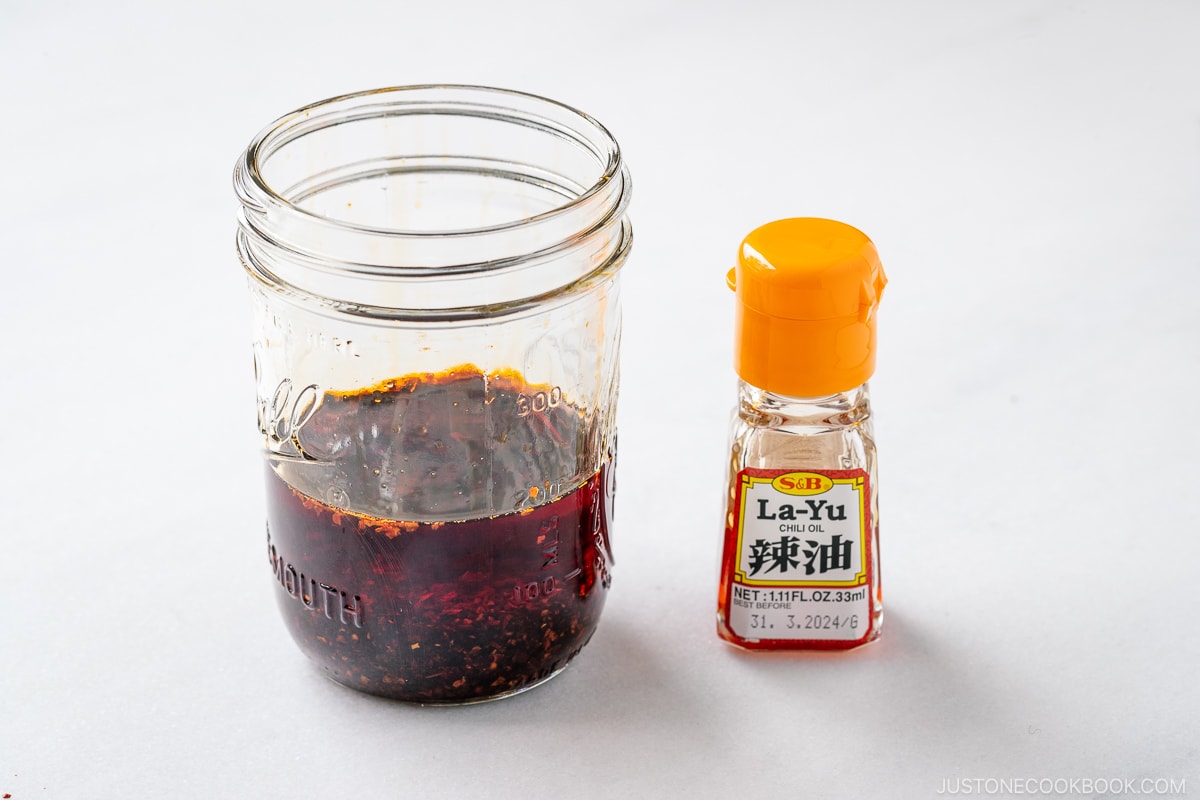
Wish to learn more about Japanese cooking? Sign up for our free newsletter to receive cooking tips & recipe updates! And stay in touch with me on Facebook, Pinterest, YouTube, and Instagram.
Homemade La-yu (Japanese Chili Oil)
Ingredients
- ½ cup neutral oil (use more for a milder flavor; I used untoasted sesame oil)
- ¼ cup toasted sesame oil
- 2 cloves garlic (sliced)
- 2 slices ginger
- 2 green parts of Tokyo negi (naga negi; long green onion) (or substitute the green parts of 4 green onions/scallions)
- ⅓ cup gochugaru (Korean pepper flakes) (coarse; you can find it on Amazon; if you like it very spicy, use Japanese ground red chili pepper (ichimi togarashi) and find it on Amazon)
- ½ tsp Sichuan peppercorns
For Finishing
- 1 Tbsp toasted sesame oil (optional; to boost the aroma and sesame flavor)
Instructions
- Gather all the ingredients.
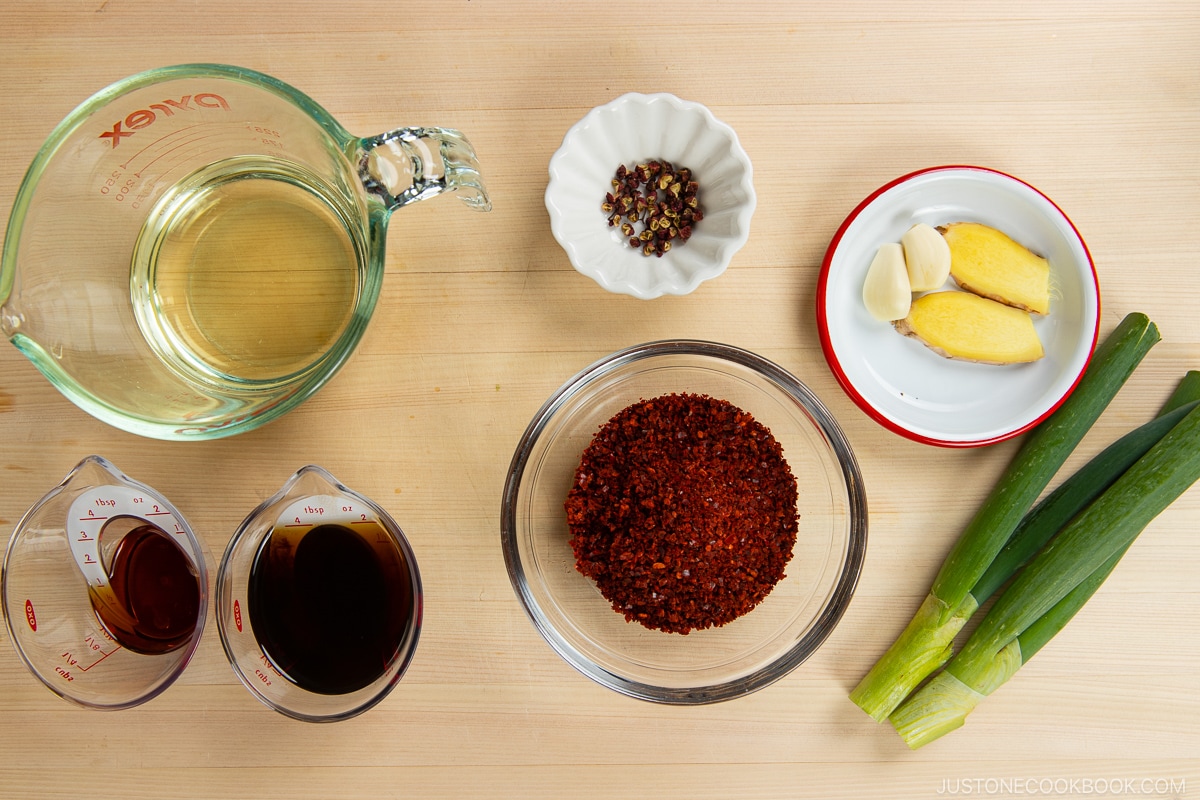
- To a wok (I use a 10" carbon steel wok; use discount code “JOC10“ for 10% off) or large frying pan, add ½ cup neutral oil, ¼ cup toasted sesame oil, 2 cloves garlic (sliced), 2 slices ginger, and 2 green parts of Tokyo negi (naga negi; long green onion) (or 4 green onions).
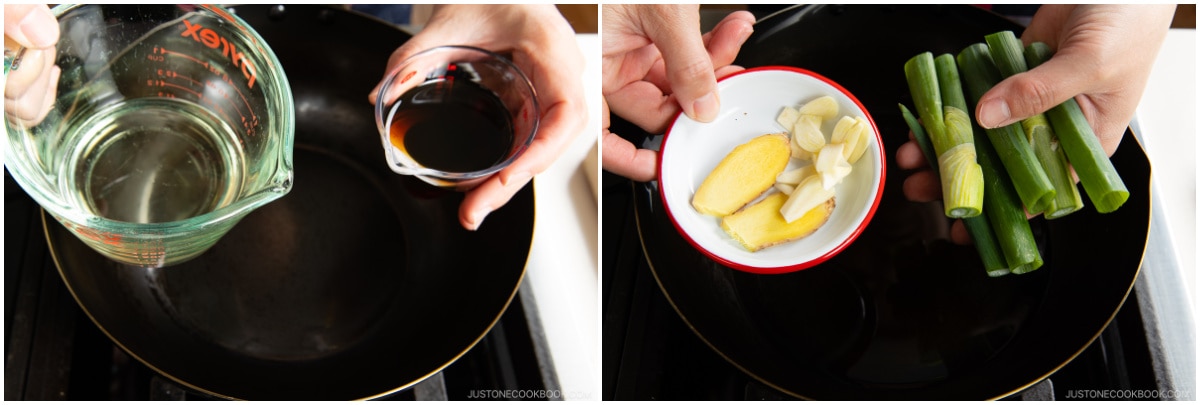
- Heat the oil mixture on low heat. Cook and slowly extract the flavors from the aromatics without burning them, for about 15 minutes from the time the oil starts sizzling. Tip: The oil will become bitter if your aromatics burn, so take care to avoid this.
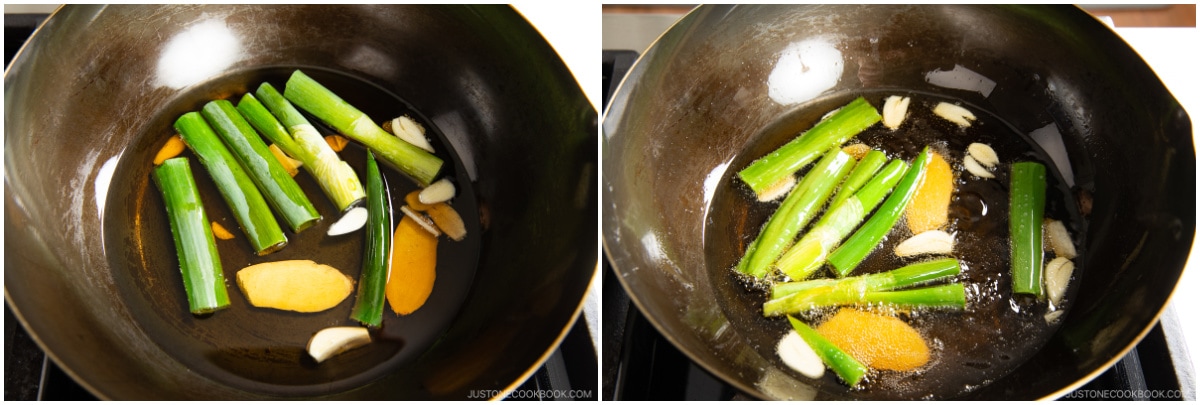
- After 15 minutes, turn off the heat. Remove the aromatics from the oil with a fine-mesh skimmer and discard them.
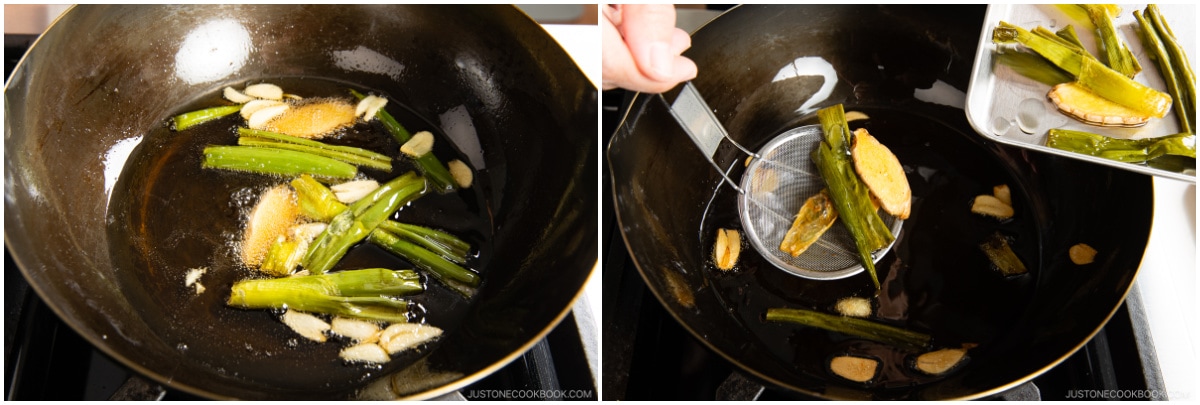
- With the stove‘s heat still off, add ⅓ cup gochugaru (Korean pepper flakes) and ½ tsp Sichuan peppercorns to the pan.
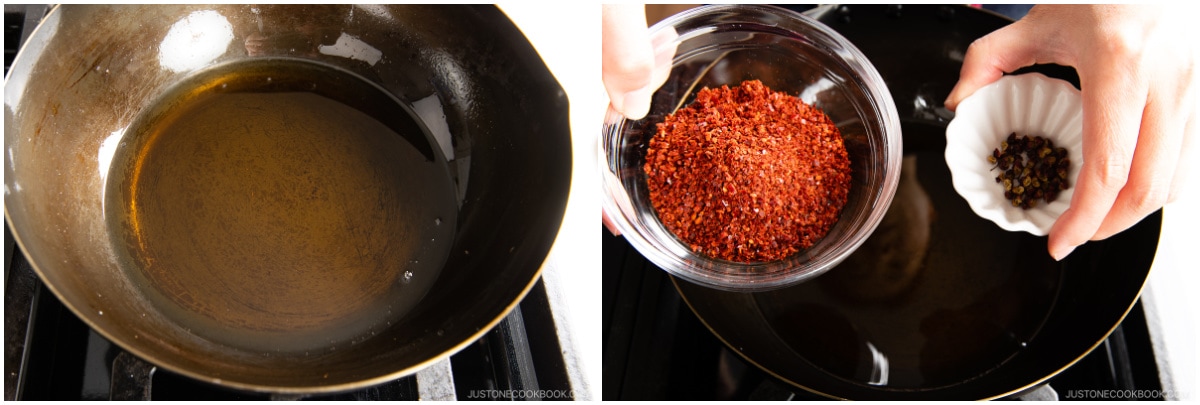
- Quickly stir and infuse the oil with the chili flakes and peppercorns using the oil‘s residual heat. The oil will sizzle when the mixture is first added and then fizzles as it cools. Allow it to steep and then cool completely to room temperature, for about 30 minutes. Once cooled, transfer the La-yu to a mason jar. Optionally, you can strain the chili flakes and peppercorns, but I like to keep them in the jar to continue infusing the oil; I also consume the chili flakes along with the chili oil. Once the La-yu has cooled, you can add 1 Tbsp toasted sesame oil (optional) to the jar of chili oil as a finishing touch. Sesame oil loses its fragrance when heated, so adding a little bit of toasted sesame oil will boost the sesame flavor and aroma.
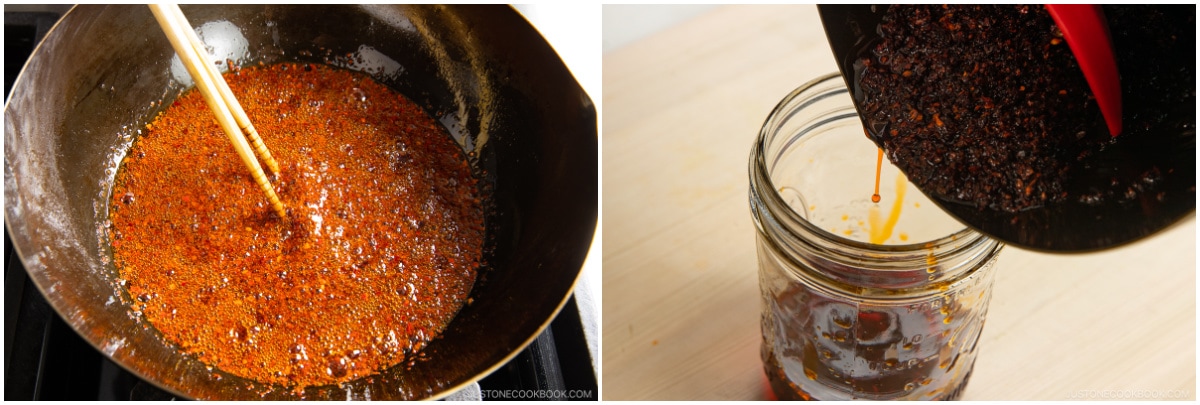
To Serve
- You can add a bit of La-yu to spice up any dish! We often use La-yu to season Japanese-style Chinese foods (Chuka ryori). You can drizzle it directly onto dishes like Miso Ramen, Black Sesame Dan Dan Noodles, and Mapo Tofu. Try it in a dipping sauce for Gyoza (Japanese Potstickers), Vegetable Gyoza, and Pork Shumai. La-yu is also delicious in a dressing for blanched vegetables like Chrysanthemum Greens Salad or in a marinade for dishes like Spicy Japanese Pickled Cucumbers and Cucumber and Chicken Marinated in Chili Oil.
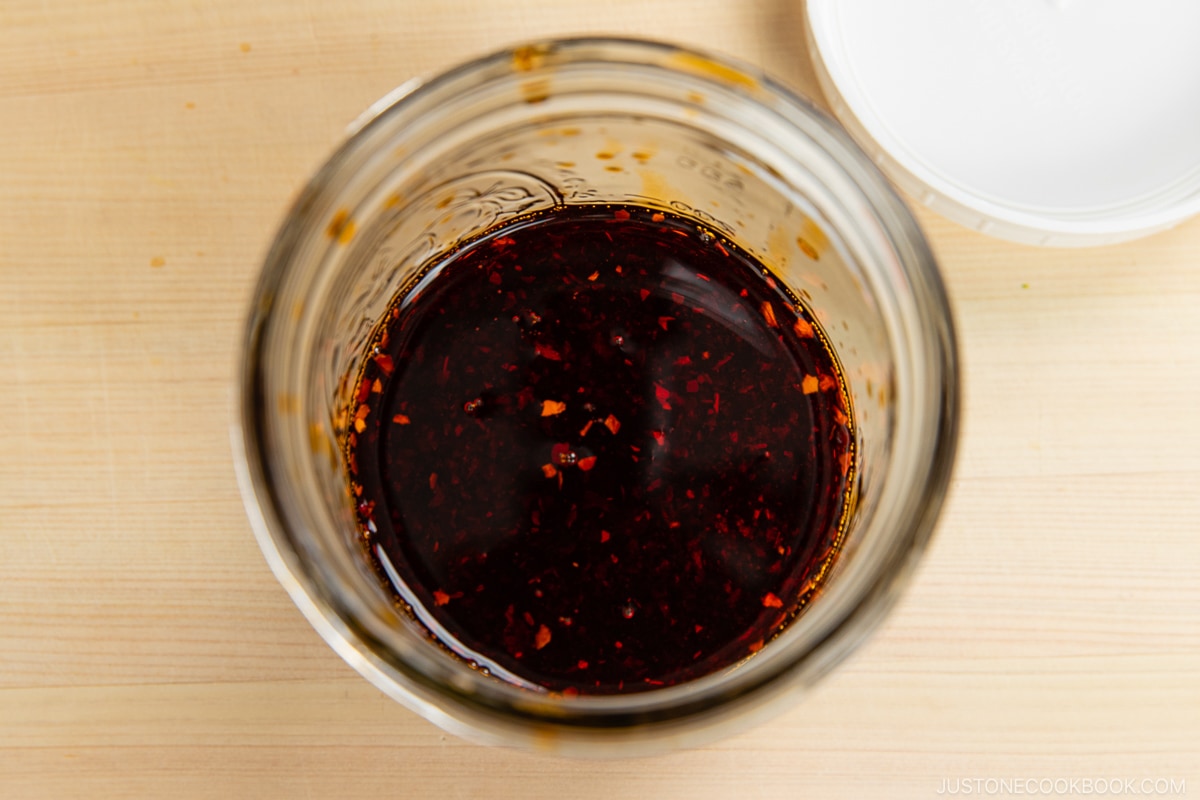
To Store
- Store the La-yu in a clean glass jar for 1–2 months in the refrigerator. Chili oil can go bad and should be discarded if it has a rancid smell or a very unpleasant flavor.
Notes
Nutrition
Did you make this recipe?
Tag @justonecookbook on Instagram so we can see your delicious creation!


